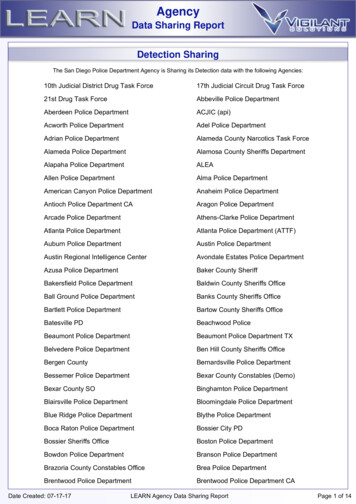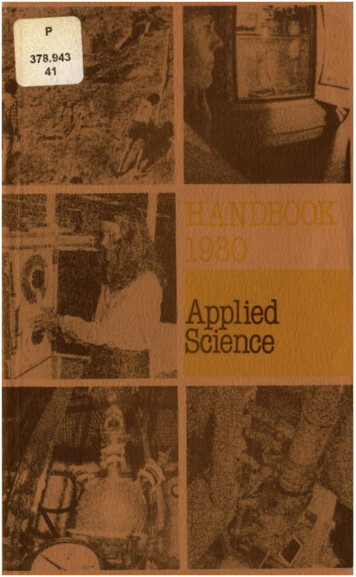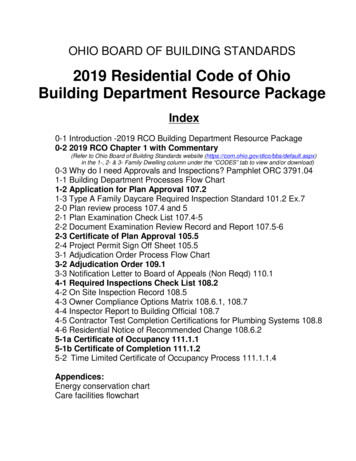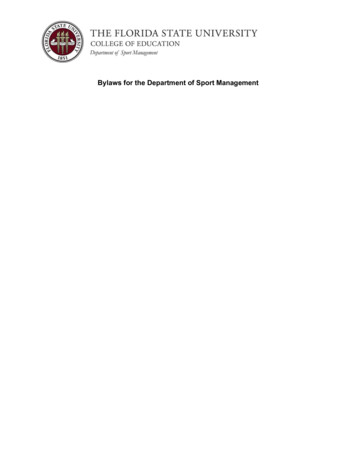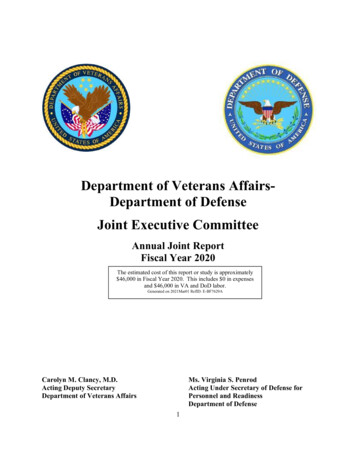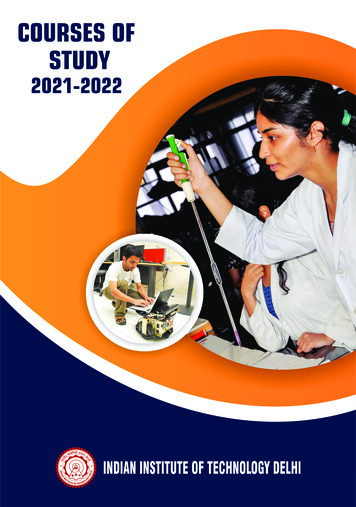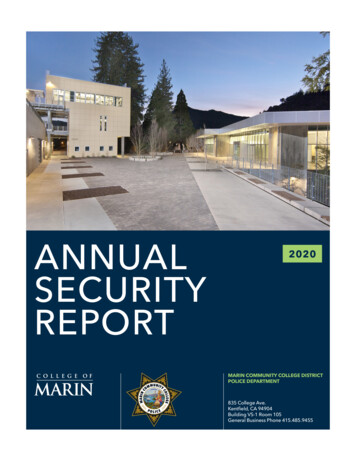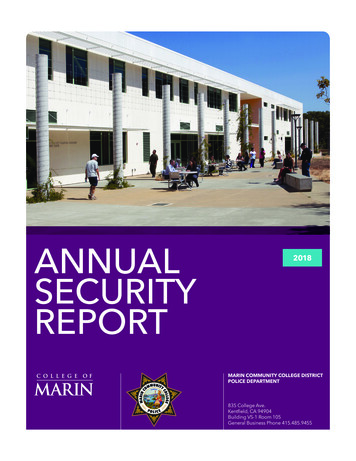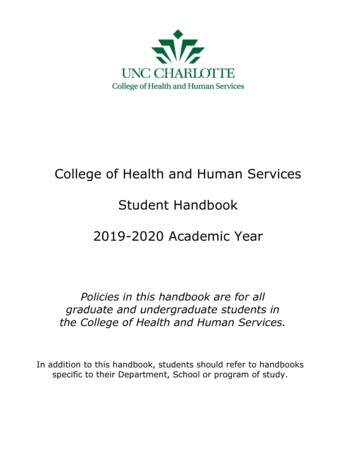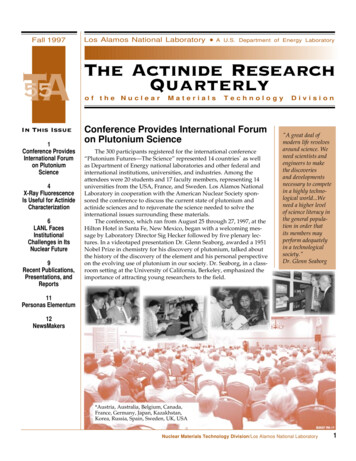
Transcription
Fall 1997TA55In This Issue1Conference ProvidesInternational Forumon PlutoniumScience4X-Ray FluorescenceIs Useful for ActinideCharacterization6LANL FacesInstitutionalChallenges in ItsNuclear Future9Recent Publications,Presentations, andReportsLos Alamos National Laboratory A U.S. Department of Energy LaboratoryThe Actinide ResearchQuarterlyof the NuclearMaterialsTechnologyConference Provides International Forumon Plutonium ScienceThe 300 participants registered for the international conference“Plutonium Futures—The Science” represented 14 countries* as wellas Department of Energy national laboratories and other federal andinternational institutions, universities, and industries. Among theattendees were 20 students and 17 faculty members, representing 14universities from the USA, France, and Sweden. Los Alamos NationalLaboratory in cooperation with the American Nuclear Society sponsored the conference to discuss the current state of plutonium andactinide sciences and to rejuvenate the science needed to solve theinternational issues surrounding these materials.The conference, which ran from August 25 through 27, 1997, at theHilton Hotel in Santa Fe, New Mexico, began with a welcoming message by Laboratory Director Sig Hecker followed by five plenary lectures. In a videotaped presentation Dr. Glenn Seaborg, awarded a 1951Nobel Prize in chemistry for his discovery of plutonium, talked aboutthe history of the discovery of the element and his personal perspectiveon the evolving use of plutonium in our society. Dr. Seaborg, in a classroom setting at the University of California, Berkeley, emphasized theimportance of attracting young researchers to the field.Division"A great deal ofmodern life revolvesaround science. Weneed scientists andengineers to makethe discoveriesand developmentsnecessary to competein a highly technological world.Weneed a higher levelof science literacy inthe general population in order thatits members mayperform adequatelyin a technologicalsociety."Dr. Glenn Seaborg11Personas Elementum12NewsMakers*Austria, Australia, Belgium, Canada,France, Germany, Japan, Kazakhstan,Korea, Russia, Spain, Sweden, UK, USANuclear Materials Technology Division/Los Alamos National Laboratory1
The Actinide Research QuarterlyA Web pagehas beenestablished forsuggestionsand commentsconcerning theconference:see http://www.lanl.gov/puconf97/This article wascontributed byAnn Mauzy, CIC-1,who covered theconference forActinide ResearchQuarterly.2Dr. Seaborg set in motion another theme ofthe conference, that of the utility and importance of plutonium and other transuranicelements in medical applications and energyand the need to better educate the publicabout the risks and benefits of these elements.He characterized nuclear energy as a rationalapproach to the dangers of various other energy sources and predicted that the depletionof those other sources willmean an eventual returnto breeder reactors andnuclear energy using bothplutonium and the mostabundant isotope of uranium, 238U.Other plenary speakers included Dr. VictorMourogov of the International Atomic EnergyAgency, Dr. Alan Waltar,Dr. Daniel Kerlinsky, andDr. Darleane Hoffman.The speakers addressedthe core science issues associated with nuclearproliferation and nuclear energy: the safestorage and ultimate disposal of surplusweapons material and management of largeinventories of actinides from civilian nuclearpower generation. Representing the “loyalopposition,” Daniel Kerlinsky, Physicians forSocial Responsibility, agreed that these werethe basic science issues and also urged international cooperation. The final plenary speaker,Dr. Darleane Hoffman, echoed Dr. Seaborg’smessage emphasizing the challenges and opportunities for basic research that plutoniumand the other actinides present.Nuclear Materials Technology Division/Los Alamos National LaboratoryThe five technical sessions that followedduring the two and a half days covered topicsunder the broad categories of materials science, transuranic waste forms, nuclear fuelsand isotopes, separations, actinides in theenvironment, detection and analysis, plutonium, and actinide compounds and complexes.The papers within these areas spanned anextremely wide range of technical topics andgave attendees a chance to learn about currentresearch outside of their particular specialties.There were more than 100 papers presentedat the conference. Among those were 12 inmaterials science, 26 in transuranic wasteforms, 5 in nuclear fuels and isotopes, 19 inseparations, 12 in actinides in the environment,9 in detection and analysis, and 13 in plutonium and actinide compounds and complexes.Topics covered the entire gamut from thegeneral, e.g., overview of work at the V. G.Khlopin Radium Institute, to the specific, e.g.,specific separations techniques for specifictypes of mixed wastes, material and thermodynamic properties, and spectroscopic studies ofactinides.In the discussions of nuclear fuels,Dr. Seaborg and a number of other speakersnoted that nearly 20% of the electricity generated around the world presently comes fromfission energy of plutonium in nuclear reactors. Others noted that about 60 metric tons ofexcess plutonium will be recovered from warheads being dismantled under the START I
Fall 1997and II agreements.The central questionis, “What is the bestway to use/disposeof this plutonium?”The need for international cooperation in answering thisquestion was nicelysummed up by Richard Rhodes, thebanquet speaker(see inset). Rhodessees plutonium as anessential resource toensure humankind’sright to live withoutstarvation. He seesnuclear energy andnuclear proliferationas global problemsthat can only besolved with globalsolutions.Rhodes ChallengesPlutonium ScientistsPulitzer Prize-winning author (TheMaking of the Atomic Bomb) RichardRhodes challenged the conferenceattendees to use the public healthmodel, the one that has eradicatedsmallpox from the earth, in solvingproblems of nuclear proliferation andnuclear energy. In his talk entitled“Public Health, Public Knowledge,Public Peace” he pointed out, “Moralizing about subjects that are essentially technical (disease was onceconsidered a punishment from God) blocks the path to finding solutions.” He placed the ban on reprocessing of spent nuclear fuel in thiscategory and pointed out that this decision ignored the fact that thereare much easier routes for proliferation.In furthering the metaphor, he urged declassification of necessaryfacts, shared open knowledge, committed individuals, and an international, nonpoliticized regime of nongovernmental agencies to enable anuclear materials management system to oversee retrievable storageof plutonium, its separation, and its burnup in power reactors. In working together, he concluded, we will be furthering the greater good: theprevention of nuclear weapons proliferation and the production ofelectrical power necessary for civilization.“Moralizingabout subjectsthat are essentially technical(disease wasonce considereda punishmentfrom God)blocks thepath to findingsolutions.”Richard RhodesNuclear Materials Technology Division/Los Alamos National Laboratory3
The Actinide Research QuarterlyX-Ray Fluorescence Is Useful forActinide CharacterizationAt the bottomis a sample ofprocess residuefrom Rocky Flatsin the form ofash, placed on apiece of tape.At the top is anelemental mapof the plutoniumdistributionwithin the ashsample usingx-raymicrofluorescence.The elementalmap was acquired with a100-micronaperture.4Although there is no “silver bullet” analytical method that can answer all questionsabout all actinide sample types and problems,x-ray fluorescence (XRF) spectrometry is oneof the myriad of analytical methods that areavailable to answer such questions. X-rayfluorescence spectrometry is a mature analytical method used to determine elementalcomposition in a wide range of sample types.The fundamental process is based uponthe removal of a core electron from the sampleby x-rays from an x-ray tube. The resultingcore electron vacancy is filled by an outer-shellelectron, which emits an x-ray that is characteristic of the element. This provides the qualitative part of the analysis or answers thequestion, “what elements are present?” Theintensity of the x-ray fluorescence detected isdirectly proportional to the concentration ofthe element in the specimen. This value givesthe quantitative part of the analysis or answersthe question, “how much of theelement is present?” This relatively simple process is usedthroughout the world in analytical laboratories and plants tomonitor processes, identify contaminants, and solve problems.At Los Alamos, XRF is an important tool in providing characterization information on a widevariety of samples and supporting a number of differentprograms.Although the fundamentalprocess is simple, the instrumentation used in XRF is neithersimple nor inexpensive. Thebasic instrumentation of powersupply, excitation source, anddetector is universally similar,but the hardware details are sufficiently complex to push instrument base prices over 100K.There are two types of XRFinstruments available, wavelength-dispersive XRF (WDXRF)and energy-dispersive XRF(EDXRF). While x-ray tubes arecommon to all XRF instruments,Nuclear Materials Technology Division/Los Alamos National Laboratorythey vary in output depending upon the instrumentation. Most WDXRF systems have highpower tubes, typically 3 kW–4 kW and usecrystals for diffracting the emitted x-rays beforethey are detected. The WDXRF instrument thusdetects elements sequentially, one at a time.There are simultaneous instruments; however,these simply have separate detector channelsfor each element. The WDXRF instruments offersensitivity, resolution, and both long- andshort-term stability.The EDXRF instruments utilize a solid-statedetector that captures all elemental x-rayssimultaneously. Their rapid analysis is offeredat the expense of spectral resolution and ultimate sensitivity. In general, both instrumentscan handle solid and liquid samples with sensitivities in the tens of parts per million. The detection limits vary by element as well as by thematrix.The routine samples we analyze by XRFinclude gallium and trace uranium in plutonium and plutonium oxide samples. Althoughother elemental methods are capable of detecting these elements, the nature of the plutoniummatrix creates additional challenges that affectthe accuracy, precision, and speed of the analysis in these other methods.The gallium and uranium analyses beginthe same with sample dissolution, followed byremoval of the plutonium matrix with ion exchange resins. The gallium is eluted from theion exchange column and collected in a beaker.Then a zinc internal standard is added, and thesample is analyzed directly. This process canprovide precision with values approaching 0.1%. The trace uranium, on the other hand,is collected and then concentrated on a resinimpregnated filter paper. This offers us sensitivities in the low parts-per-million range.While precision is not an issue, this methodavoids the isotopic interference from the plutonium matrix. Both of these analyses supportsuch programs as pit rebuilding, surveillance,and development of mixed-oxide (MOX) fuels.Other analyses involving actinide materialsare applied to samples from Hanford andRocky Flats. In these analyses, the sludge or ashparticles are analyzed directly to provide aqualitative identification of the elements
Fall 1997present. We are currently developing asemiquantitative method that will provideboth qualitative identification and relativequantitative values of the detected elements.Although this analysis will not provide absolute concentrations, the values will be referenced to known standards for lot-to-lotcomparisons. This procedure takes advantageof the rapid sample analysis and minimumsample preparation requirements, keeps theper sample costs low, yet still provides theneeded composition information on thesample.The Source Term Testing Program (STTP)project is another area where XRF is providingqualitative and quantitative data. In STTPbrine samples are withdrawn from test containers and filtered. The XRF team receivesboth the brine and filters for analysis. The XRFresults give a picture of what is dissolved inthe brine and what is suspended within theliquid phase of the test material. Both sampletypes offer challenges in analysis since calibration standards that match the matrix of the unknowns must be fabricated. Although theseanalyses are not absolute because of the widelyvarying test container compositions, the valuesprovide a relative scale for comparing the effects of the brine interactions with the differentwaste forms being tested.In addition to these routine methods, weare actively pursuing new and innovativeways to use XRF so we can meet future characterization needs. One area of research is theuse of x-ray microfluorescence (XRMF), whichutilizes a spatially restricted x-ray beam to excite a specific location on a specimen. The detected x-rays are localized and can provideinformation on heterogeneity, inclusions, thinfilms, and interfaces. Our current program hasseveral thrusts that offer new approaches toactinide characterization. The dried spotmethod has the potential for rapid, multielemental analysis on small masses of volumesof material. The method utilizes 10-ml to 50-mldrops of solution, which are dried. The resulting dried residue, which is mere microgramsof material, is analyzed with sensitivities approaching less than 1 part per billion. This is 3orders of magnitude better than conventional,bulk XRF. Theprimary advantage lies in thesmall samplesize, which alsohelps to keep exposures to personnel as low asreasonablyachievable insample handlingand analysis.Rapid, spatially resolved analysis of MOXsurrogates is providing insights into the evolution of gallium from potential MOX reactorfuel pellets. The presence of gallium is a critical issue for disposing of weapons plutoniumin MOX fuel. Although most of the galliumcan be removed, the mechanism of the removal process and behavior of the residualgallium need to be studied. The capabilities ofXRMF allow us to study the gallium behavioron a scale that does not require the high resolution of a scanning electron microscope.Finally, the ultimate goal is to develop aninstrument that uses chemical images to provide both elemental and molecular information simultaneously. These chemical imageswill rapidly transmit both qualitative andquantitative, spatially resolved information onthe elemental and molecular composition ofthe sample. This vision is based on integratingelemental and molecular spectroscopic datafrom XRMF, micro-Raman, micro-FTIR (Fourier transform infrared spectroscopy) andx-ray microdiffraction. The principal advantage of this integrated approach is thenondestructive, comprehensive chemicalinformation on either small samples orspatially resolved images of macroscalespecimens. This multiplexing of spectroscopicinformation would improve characterizationaccuracy and minimize multiple samplepreparations to solve analytical problems.This is just a snapshot of the importanceof only one analytical method and how analytical chemistry as a whole underpins actinide science and actinide production effortsand how analytical science impacts all of thescientific efforts at Los Alamos.Joel Dahlby,CST-8, operatesan x-raymicrofluorescenceinstrument, aninnovative use ofXRF to excite aspecific locationon a specimen.The techniquecan be used toperform spatiallyresolvedelementalanalysis forconcentrations of10 ppm to weightpercent levels.In addition toPrincipalInvestigatorGeorge J. Havrilla,the XRF TeamincludesBill Hutchinson,Margie Moore,Lisa Colletti,Forrest Weesner,and ChristopherWorley ofCST-8 and JonSchoonover ofCST-4.Nuclear Materials Technology Division/Los Alamos National Laboratory5
The Actinide Research QuarterlyLANL Faces Institutional Challengesin Its Nuclear FutureTodd LaPorteis a professor ofPolitical Scienceat the Universityof California,Berkeley.Dr. LaPorte wasan "ex officio"member of the1996 NMTScience andTechnologyAssessmentReviewCommittee.6Social scientists rarely have the opportunity to become familiar with operations thatcombine demanding technologies, high national purpose, and extraordinary institutionalchallenges. Such an opportunity was affordedme this year by the Nuclear Material Technology (NMT) Division and the Nuclear Materialsand Stockpile Management Program Office. The experience wasat once engaging, informing, andunsettling. This editorial reflectsmy unusual view of LANL’s evolution and could be seen, in part,as a letter to those who so graciously became my teachers.As the readers of this quarterly know, LANL, especially itsplutonium-handling facilities(Technical Area-55, managed byNMT), has been tasked to demonstrate its ability to become thenation’s leading organizationwith the capacity for “pitremanufacture,” i.e., periodic remanufactureof the plutonium components needed to maintain nuclear weapons in a state of highly reliable readiness. Since there is no other facilitywith sufficient capacity, TA-55 is, in effect, theU.S. plutonium fabricator of last resort, a facility that is likely to be required for the foreseeable future.In taking up its expanded role, LANL hasjoined with DOE in using the metaphor of“stewardship” to focus on these responsibilities and public service. With regard to managing nuclear materials, especially in the comingera of regulatory transparency, the role of “institutional steward” is quite extraordinary. Tothe attentive public, “stewardship” is likely toimply that LANL and DOE are claiming theycan assure highly reliable operations for manywork and management generations, perhapsfor hundreds of years, in a manner that evokesdeep, sustained public trust and confidence.Nuclear Materials Technology Division/Los Alamos National LaboratoryFrom an institutional perspective, these arevery demanding goals to achieve and sustain.Indeed, the recent extension of LANL’s mission challenges our capacity to maintain anorganization’s operational balance and tosuccessfully navigate the turbulent watersof national politics.The Lab and NMT already demonstratean understanding of highly reliable operations. The requisites for evoking the public’strust and confidence are more problematicbut have drawn a good deal of comment andsome analysis. I leave this discussion for another venue. Assuring high performance inthe spirit of stewardship for many generations, i.e., “institutional constancy,” is anothermatter. It is an unexpected, unfamiliar, thoughapt challenge. Institutional constancy is aprime condition undergirding the exercise ofhonorable institutional stewardship. It is notwell understood and is unexpected within anAmerican political culture that lauds changeand shrinks from continuities of power.Institutional constancy implies the faithfuladherence to a mission and its operationalimperatives in the face of a variety of socialand institutional changes and requiresadaptability to meet institutional andpublic commitments.LANL already seeks to assure continuityof top technical talent in its recruiting andmentoring activities, key mechanisms in socializing and training generations of able professionals in the spirit of enterprise. But thereare only meager analytical bases for achievingorganizational qualities that address the challenge of constancy. What little that has beendone suggests that these qualities requiresteadfast political will and what one mightcall the “organizational infrastructure ofconstancy.”
Fall 1997Political will is likely to be enhanced bystrong articulation of commitments by agencyleaders to unswerving adherence to the spiritof the initial agreement as well as vigorous external reinforcement from regulatory agenciesand public “watchdog groups.” The organizational infrastructure of constancy is less familiar and includes administrative and technical capacitiesto carry out constancy-assuringactivities reinforced by agency rewardsfor pursuing them; adequate resources and activities toassure the transfer of technical andinstitutional knowledge from one workand management generation to the next; analytical resources for future impactanalyses; and capacities to detect and remedy the earlyonset of likely failure related toprocesses that threaten the future, aswell as assurance of remediation iffailures actually occur.Institutional constancy must be seen interms of the missions animating an institution—in the case of LANL and NMT—researchand development goals. The challenge in thefuture will be to integrate R&D with excellencein specialty production, activities that someobservers believe to be intrinsically at odds.The dimensions of this challenge are suggestedby the objectives the U.S. seems to be pursuing, i.e., to manage nuclear materials in a manner that 1) emphasizes a self-conscious spirit ofsustained institutional stewardship; 2) aims tobe the best in the world, not only in the U.S.;and 3) equips technical and operational professionals to demonstrate, via their interactionswith professional counterparts throughout theworld, that the U.S. retains an effective nuclearweapons deterrent capacity for the indefinitefuture.These are as unusual and demanding a setof institutional goals as ever to be proposedfor technical organizations and programs.Goals 1) and 3) above have rarely been sought,authorized, or supported by sponsors in thepast, nor are they particularly honored by political, media, or economic leaders in our political culture. Yet the multigenerationaldemands of these goals raise the issue of “institutional honor,” a topic almost absent fromorganizational studies and broached only hesitantly in technical professional conversation.Our generation is, in effect, handing downundeniable demands to the fourth and fifthgenerations. Meeting these demands will bedifficult, especially in view of the fact that themajor benefits of nuclear deterrence have accrued to the present generation but with muchof their cost deferred to future generations.Will these obligations requiring some of theirgenerations’ best and brightest be readilytaken up by our descendants? Will it be anhonorable and honored “taking up”? As thepolitical situation that bolstered the dedicationof national resources to nuclear stewardshipattenuates with time, future generations without our frame of reference may find our “gift”increasingly onerous. The conditions necessary to nurture an honored institution withinthe society at large apply as well to accordinghonor to technical production activities andresearch and development so that sustained,high-quality technical operations may beensured.In the context of LANL’s past, this discussion may seem unduly alarming. After all,LANL, under the benign oversight of the University of California system, has repeatedlymade unique and invaluable contributions toadvance basic scientific knowledge and toovercome a vigorous adversary. Couldn’t weexpect the same “world class” performancein the new era? Perhaps, but to leave it theremisses the emerging public skepticism regarding technical systems generally, a particularly"Indeed,the recentextensionof LANL’smissionchallengesour capacityto maintain anorganization’soperationalbalance andto successfully navigatethe turbulentwaters ofnationalpolitics."continued on next pageNuclear Materials Technology Division/Los Alamos National Laboratory7
The Actinide Research QuarterlyLANL Faces Institutional Challengesin Its Nuclear Future (continued)acerbic skepticism regarding the nuclear enterprise. It can be argued that those who aretechnically engaged in the various aspects ofthis enterprise have not been particularly wellserved by their governmental or commercialsponsors and promoters. Recent history suggests failures of institutional competence,policy determination, and public disclosure.The accumulation of these failures exhaustspublic patience, erodes confidence in technicalprofessionals (and their overseers), andaccretes layers of resentment harbored in thesocial psyches of a distracted and anxiouspublic.While the technical parameters of “science-based stockpile stewardship” may be inthe process of becoming clarified, operationallineaments remain opaque and institutionalimperatives illusive. This presents the currentleadership not only with demanding technicalobstacles, but with extraordinary institutionalones as well. The metaphor of stewardship isapt and warranted. Offered in the face of historical residues and evolving conditions, thatstewardship lays demanding charges uponcurrent leadership and taxes our institutionalcapacities. It also taxes our abilities to frameperspectives that acknowledge the politicalstrain intrinsic to maintaining those technicalcapabilities that have been central to achievingglobal dominance.It is possible, perhaps likely, that leadersin Washington have neither the capacity northe full resolve to initiate the necessary stewardship-enhancing changes. To the degree thisis so, developments in the relationships ofLANL with the external world and changeswithin the weapons programs themselvesmust be initiated mostly from within the Lab,probably in the face of at least residual resistance from its overseers. But if stewardshipenhancing measures are broadly effective,technical and institutional leaders will recoverthe confidence of able Americans. This is arequisite to nurture a climate of understandingand honor in which each generation assumesthe obligation of managing the burden ofnuclear weapons and materials in such a waythat their successors in the “fourth generation”will inherit a system at least no more difficultto manage than the one they received.It will be a challenge. There is no crediblebasis for confidently selecting out those organizational solutions that will be suitable forthe future on the basis of short-term managerial, economic, or political considerations. Ineffect, we could, in all good-hearted earnestness, start out wrong, as history would surelynote.Todd LaPorteThe ideas presented in this editorial are theauthor's and do not necessarily represent theopinion of Los Alamos National Laboratory, theUniversity of California, the Department ofEnergy, or the U.S. government.8Nuclear Materials Technology Division/Los Alamos National Laboratory
Fall 1997Publications,Presentations, and Reports(April 1997–September 1997)Journal PublicationsM. P. Neu, S. D. Reilly, and W. Runde, “Plutonium Solubility andSpeciation to be Applied to the Separation of Hydrothermal WasteTreatment Effluent,” Materials Research Society Symposium ProceedingsSeries, II. Scientific Basis for Nuclear Waste Management XX, Volume 465,in press.H. T. Hawkins, B. E. Scheetz, and G. D. Guthrie, Jr., “Preparation ofMonophasic (NZP) Radiophases: Potential Host Matrices for the Immobilization of Reprocessed Commercial High-Level Wastes,” MaterialsResearch Society Symposium Proceedings Series, II. Scientific Basis forNuclear Waste Management XX, Volume 465, W. J. Gray and I. R. Triayeds., 387-394, Materials Research Society, Pittsburgh, PA (1997).M. D. Diener, C. A. Smith, and D. K. Veirs, “Anaerobic Preparation andSolvent Free Separation of Uranium Endohedral Metallofullerenes,”J. Chem. of Materials, 9(#8), 1773–1777, (1997).D. G. Kolman and J. R. Scully, “On the Requirement for a Sharp Notchor Precrack to Cause Environmentally Assisted Crack Initiation of BetaTitanium Alloys Exposed to Aqueous Chloride Environments,” to bepublished in Effects of the Environment on the Initiation of Crack Growth,ASTM STP 1298, (W. A. Van der Sluys, R. S. Piascik, and R. Zawierucha,Eds., American Society for Testing and Materials, Philadelphia, PA1997).D. G. Kolman and J. R. Scully, “An Explanation for the pH and PotentialDependency of b-Titanium Alloy EAC Initiation in Aqueous ChlorideEnvironments Based on an Investigation of Crack Tip Electrode Kinetics,” Metallurgical Transactions A, in press.D. G. Kolman and J. R. Scully, “Comparison of Anodic Current Transients Resulting from Film Rupture on a Dynamically Strained Metastable b-Titanium Electrode to Those Observed Following FracturedThin Film and Scratch Depassivation,” J. Electrochem. Soc., in review.Conference PresentationsThe following papers were presented at the American Chemical SocietyNational Meeting, San Francisco, CA, April 13–17, 1997: U. F. Gallegosand M. A. Williamson, “Molten Salt Electrochemistry”; R. R. Salazar,B. J. Griego, L. D. Schulte, S. D. McKee, W. B. Smith, M. J. Palmer, andV. A. Hatler, “Oxalate Precipitation of Pu(III) from Very Dilute HClSolutions”; G. M. Purdy, G. D. Jarvinen, B. F. Smith, M. Cournoyer,and R. R. Gibson, “Polymer Filteration: An Emerging Technology forSelective Metals Recovery” (Division of Chemical Technicians);J. L. Lugo, D. E. Wedman, and T. O. Nelson, “Electrochemical Decontamination of Actinide Processing Gloveboxes”; R. B. Vaughn,J. M. Berg, and M. R. Cisneros, “The Use of Absorption Spectroscopyof Plutonium to Minimize Waste Streams”; L. A. Worl, D. D. Padilla,D. K. Veirs, S. J. Buelow, L. A. Le, andJ. H. Roberts, “Hydrothermal Processing ofActinide Contaminated Organic Wastes,”LA-UR-96-3796; M. Barr, G. Jarvinen,S. F. Marsh, and R. Bartsch, “Developmentof Anion-Exchange Resins for Separationsof Actinides,” LA-UR-96-3933; D. K. Ford,R. Scott Lillard, and D. P. Butt, “CorrosionStudy of Candidate APT Engineering Materials,” LA-UR-96-4078; and J. M. Berg,R. B. Vaughn, M. R. Cisneros, D. K. Veirs, andC. A. Smith, “Optical Studies of the Stoichiometry and Thermodynamics of Plutonium (IV)Nitrate Complexes in High Ionic StrengthAcidic Solutions,” LA-UR-96-4537.The following papers were presented at theANS Topical Conference on Methods andApplications of Radioanalytical Chemistry,Kailua-Kona, Hawaii, April 6–11, 1997:K. W. Fife, “A Kinetic Study of PlutoniumDioxide Dissolution in Hydrochloric AcidUsing Iron(II) as
Richard Rhodes Rhodes Challenges Plutonium Scientists Pulitzer Prize-winning author (The Making of the Atomic Bomb) Richard Rhodes challenged the conference attendees to use the public health model, the one that has eradicated smallpox from the earth, in solving problems of nuclear proliferation and nuclear energy. In his talk entitled
